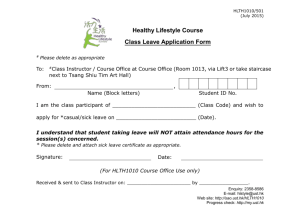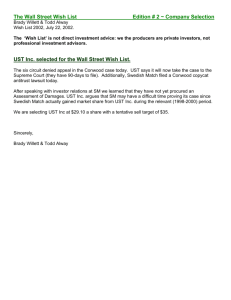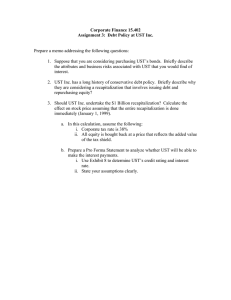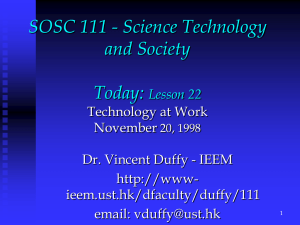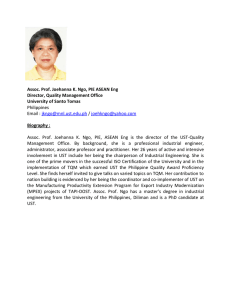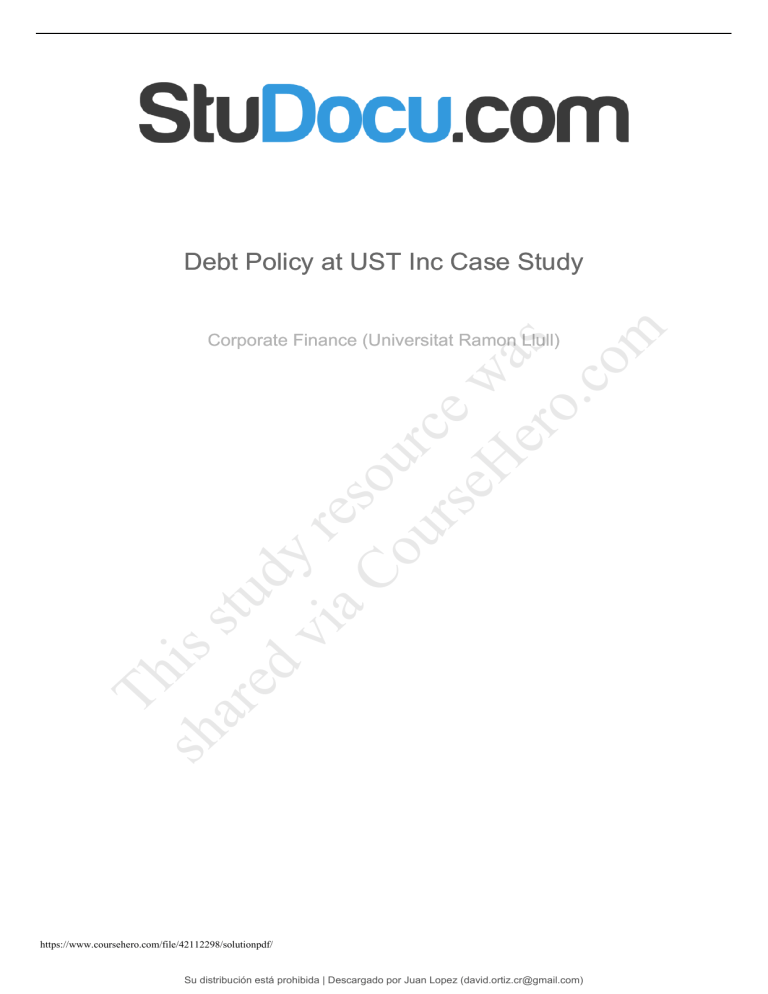
lOMoARcPSD|2903586 ar stu ed d vi y re aC s o ou urc rs e eH w er as o. co m Debt Policy at UST Inc Case Study sh Th is Corporate Finance (Universitat Ramon Llull) https://www.coursehero.com/file/42112298/solutionpdf/ Su distribución está prohibida | Descargado por Juan Lopez (david.ortiz.cr@gmail.com) ar stu ed d vi y re aC s o ou urc rs e eH w er as o. co m lOMoARcPSD|2903586 Debt Policy at UST (1998) CORPORATE FINANCE – CASE 2 MSc Finance, Section B sh Th is A. Anthony R. Barradas Ferreira J. Frick F. Hädicke S. Hintze ESADE Class 2017/2018 February 2018 https://www.coursehero.com/file/42112298/solutionpdf/ Su distribución está prohibida | Descargado por Juan Lopez (david.ortiz.cr@gmail.com) lOMoARcPSD|2903586 Question 1 Business Risks: Despite its high profitability in previous years and having the highest market share, UST faces several business and financial risks. The most pressing risks we identified are compliance risk and strategic risk. ar stu ed d vi y re aC s o ou urc rs e eH w er as o. co m Strategic Risk: We believe that in the short term, sales will slightly decrease, due to low cost brands that are entering the market and eroding UST’s share. Instead of acknowledging new market entrants, UST relied on its strong position. This resulted in slowing down innovation and the failure of introducing new product ranges, which had led to its success in the first place. Consequently, UST gradually lost total market share in the moist smokeless tobacco industry (-1.8% CAGR over 7 years). Concerning cyclicality, the tobacco industry does not experience seasonal sales volatility. In the price-value market segment, UST failed to obtain considerable market share and instead let smaller competitors grow over the past years in an already competitive segment. The reliance on its core brands and the failure to serve the price-value segment had a negative impact on UST’s market position and growth potential . Finally, long-term outlooks for UST’s performance, due to the new value brands, more regulated smokeless tobacco industry and no opportunity for global expansion, are uncertain and add to UST’s business risk. Compliance Risk: As the tobacco industry is becoming more regulated especially concerning advertisement and regulatory bodies, which are determined to label nicotine as a drug in the future, UST faces severe compliance risks. Restrictions will further impede the ability to justify the high margins on its premium brands and increase reputation risk. As a result, UST will risk sales growth in its premium brands due to constraints in addressing young customers and a trend in the society towards more health consciousness. Additionally, continuing litigation risks from lawsuits filed by competitors will further exacerbate UST’s restrictions and financial obligations. is Financial Risks: sh Th Credit risk: UST’s ability to raise capital is based on its bond rating. Therefore, in order to assess its credit risk, we compared determining multiples in relation to its peers. With its current capital structure, UST yields ratios well above AAA-thresholds. With the change in capital structure due the USD 1.0 bn loan, however, the rating is expected to fall to an A-level (see Q2). Therefore, credit risk is expected to increase, however we do not perceive it as critical. Capital risk: We expect cost of capital to increase due to the new capital structure. In 1998, the debt ratio equaled 10.95%. In 1999, UST will experience a skyrocketing increase of its debt ratio to 120.44% due to the issuance of USD 1.0 bn in debt (see appendix table “Financial Ratios”). Commodity prices: UST buys tobacco from domestic suppliers exclusively. Therefore, the company was not exposed to any foreign exchange rate risks for its major raw material. Domestic tobacco prices depend on domestic tobacco production, which was still regulated by a quota in 1998. The only risk inherent in the rising commodity prices was, consequently, unfavourable weather conditions. https://www.coursehero.com/file/42112298/solutionpdf/ 1 Su distribución está prohibida | Descargado por Juan Lopez (david.ortiz.cr@gmail.com) lOMoARcPSD|2903586 With the termination of the quota in coming years, raw material prices are expected to decrease. 1 Hence, commodity prices are no financial risk factor for UST but rather offer potential upsides in terms of margins or increased flexibility regarding pricing policies. Revenue structure: Due to UST’s aforementioned decreasing market share, its weak position in the growing price-value market segment and impeding regulation for marketing , we expect sales to grow at a decreasing rate. Despite a 10-yr CAGR of 9% and a 5-yr CAGR of 5%, growth decreased steadily from 1996 to 1998 from 5.05% to 2.19% and 1.53% respectively. Furthermore, UST’s price increases in previous years caused a decreasing market share (-1.7% 7-yr CAGR) and paved opportunities for new competition to enter the market. From this we infer that UST will be forced to decrease price margins, which will further decrease one of its historical pillars of sale growth and profitability. ar stu ed d vi y re aC s o ou urc rs e eH w er as o. co m Stock prices: Stock price valuation is at risk due to UST’s abandonment of historically stable dividend payment and investors’ concerns about UST’s capability to innovate its product line. However, UST’s plans to change its capital structure, which will improve EPS ratios. Therefore, we do not consider stock prices as a risk factor. Opinion on UST’s capital structure: In our opinion, the recapitalization strategy, which adds financial leverage to the company is beneficial, as the increased debt adds value to the firm due to the tax shield (see question 3). Regarding shareholders, the change in capital structure increases not only the return on equity, but also earnings per share. In addition, UST has a stable net income and free cash flows, which can support debt repayments. Benefits of debt for UST: Th is UST intends to use the credit to repurchase its shares in the market, which it had initially planned in 2006. As a result of the recapitalization, UST will lower its shares outstanding, which ultimately will improve EPS figures to USD 2.70 (see appendix). Shares outstanding decreased to 156.8 m shares, and EPS increase to USD 2.68, due to lower shares outstanding and steady projected net income. If the company believes its stock is undervalued, the company will buy back a set amount of shares outstanding and once the stock price moves back up, reissue the same number of shares at the new higher price. This increases total equity while keeping the number of shares outstanding stable. sh Another benefit of the debt is the resulting tax shield. Regarding the tax shield, we made our calculations based on interest expenses at a 7.05% interest rate. The resulting tax shield amounts to USD 29.52 m, which reduces taxes payable due to interest expense tax deductibility and increased significantly due to the new debt issuance. From a financing perspective, debt is cheaper than equity, because equity tends to be riskier, due to the seniority of repayments in case of liquidation. Additionally firms are not obliged to pay dividends to common shareholders, thus shareholders will require a higher rate of return on equity as compensation. Because bond holders are obliged to payments, debt tends to be less risky and therefore the cost of debt is cheaper than the cost of equity. Due to the leverage effect of debt, UST will have a 1 UST Inc. Form 10-K Securities and Exchange Commission 2004, page 5. https://www.coursehero.com/file/42112298/solutionpdf/ 2 Su distribución está prohibida | Descargado por Juan Lopez (david.ortiz.cr@gmail.com) lOMoARcPSD|2903586 higher return on equity, which also benefits the shareholders. In addition, being able to get a credit is often seen as a positive signal, as this means that the firm went through rigorous credit checks and 2 extensively has proven its liquidity. Question 2 From a quantitative perspective, we focused on both the EBIT and EBITDA interest coverage ratios for the company assuming the industry average Corporate Bond Yields for 20-yr bonds as a base for our calculations. We decided to use the 20-yr bonds because its is the longest time frame included in the case and the closest one to a bond issued in perpetuity. We derived the interest coverage ratios for UST based on three different growth scenarios for the different S&P rating categories and compared them to the industry average in order to see which one best fitted UST (see appendix). ar stu ed d vi y re aC s o ou urc rs e eH w er as o. co m Under growth assumptions for the scenarios, we expect UST’s new debt to be classified as “A” or even “A+”, based on a 10.8x and 11.3x EBIT and EBITDA interest coverage ratios, respectively (see appendix). Our assessment is in line with Standard & Poor’s actual rating. When assessing the credit rating of a company it is important to not only look at its financial ratios, but also to consider some more qualitative aspects of the overall company profile. Despite the recent slowdown in the market, the barriers to entry for new competitors due to regulatory requirements and marketing limitations help UST to preserve its continued growth, maintaining a strong position in the premium segment, which has proven highly profitable in the past. UST has maintained a steady price growth rate throughout the years. The major drawback from UST’s recent strategy is a certain lack of innovation in its core business, with just one newly launched price-value brand, and a poor portfolio diversification, as their non-core operations have proven unsuccessful in contributing to just 12% of sales and 3% of operating profit. The company is also dependent of the US market as there are no immediate opportunities for international expansion. Th is In terms of UST’s market position and brand name recognition, the company is the undisputed market leader in the industry, with a 77.2% market share. However, UST’s success is almost exclusively linked to the premium market. In the price-value market, the company only has an established market share of approximately 0.6%, the current discrepancy on UST’s position in the two market segments can become an issue in the long term as the price-value market is becoming more competitive with more brands being introduced and growth at a 40.5% 7-yr CAGR, whereas the premium segment is decreasing at a 1.5% 7-year CAGR. sh Looking at UST’s current financial ratios and potential for growth, the company remains highly profitable, with the highest ROE, ROA, and profit margins of the industry. Its ability to generate future cash flows and maintain its financial obligations are also expected to grow steadily. It was considered the most profitable US company in both 1997 and 1998, which is understandable since the premium segment, in which UST dominates, still accounts for about 80% of the overall industry. Another important aspect to consider is that the issue of new debt is solely destined for the share buyback program, and as far as we can assess, the company does not plan any acquisitions, R&D 2 M ontreal Finance. 2011. 7 Reasons Why Debt is Good for your Business. https://www.coursehero.com/file/42112298/solutionpdf/ 3 Su distribución está prohibida | Descargado por Juan Lopez (david.ortiz.cr@gmail.com) lOMoARcPSD|2903586 investments or establishment of strengthened sales teams as a strategy to better penetrate the price-value market. Question 3 Th is ar stu ed d vi y re aC s o ou urc rs e eH w er as o. co m In order to calculate the impact of the change in capital structure on UST’s value, we first calculated the value of the unlevered firm and then added the tax shield (see appendix). In order to determine the value of the unlevered firm, we first calculated the firm’s cost of equity using the CAPM. The risk free rate in our case equals the rate of a S&P A-rated 20-yr treasury bond. The return of the market was evaluated by using the simple return of the NYSE Composite Index for the year 1998. Finding historical figures for the beta proved to be extremely difficult, so we had to assume that the beta of the tobacco industry today is the same as it was in 1998. Based on data by Damodaran (see appendix), the beta for the tobacco industry in 2018 equals 1.12. This figure seemed extremely high to us, as we believe that due to the price elasticity of the tobacco industry the beta should be below 1. We therefore 3 computed the average of the betas of Philip Morris, Altria Group, which acquired UST Inc. in 2008 , and British American Tobacco and derived an industry beta of 0.68. Next, we calculated the tax shield in order to determine the value added due to the newly issued debt. Using these figures, we calculated the tax shield with three different costs of debt from 20-yr corporate bonds, a conservative (BBB), a base case as per our rating derived in Q2 (A), and an optimistic (AA) scenario. The value added due to the resulting tax shield equals roughly USD 418 million under all scenarios. The tax shields under the different scenarios represent 8.95%. sh Regarding the repurchase of existing shares through the open market, the recapitalization strategy resulted in the number of shares outstanding decreasing by 28.7 m to 156.8 m shares. As a basis for our calculation we used the year end stock price of USD 34.88. The decrease in shares outstanding leads to an increase in earnings per share from USD 2.52 to USD 2.70, benefitting the remaining shareholders. Furthermore, we started calculating the bankruptcy cost. However, due to its insignificance, we decided to restrain from further calculations. 3 https://dealbook.nytimes.com/2008/09/08/altria-buys-smokeless-tobacco-maker-for-104-billion/ https://www.coursehero.com/file/42112298/solutionpdf/ 4 Su distribución está prohibida | Descargado por Juan Lopez (david.ortiz.cr@gmail.com) lOMoARcPSD|2903586 sh Th is ar stu ed d vi y re aC s o ou urc rs e eH w er as o. co m Appendix https://www.coursehero.com/file/42112298/solutionpdf/ 5 Su distribución está prohibida | Descargado por Juan Lopez (david.ortiz.cr@gmail.com) Powered by TCPDF (www.tcpdf.org)

